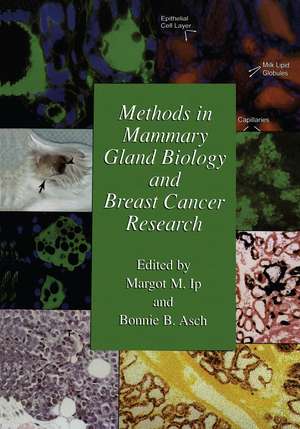Methods in Mammary Gland Biology and Breast Cancer Research
Editat de Margot M. Ip, Bonnie B. Aschen Limba Engleză Paperback – 12 oct 2012
| Toate formatele și edițiile | Preț | Express |
|---|---|---|
| Paperback (1) | 1417.75 lei 6-8 săpt. | |
| Springer Us – 12 oct 2012 | 1417.75 lei 6-8 săpt. | |
| Hardback (1) | 1423.58 lei 6-8 săpt. | |
| Springer Us – 30 dec 2000 | 1423.58 lei 6-8 săpt. |
Preț: 1417.75 lei
Preț vechi: 1492.37 lei
-5% Nou
Puncte Express: 2127
Preț estimativ în valută:
271.32€ • 277.86$ • 225.69£
271.32€ • 277.86$ • 225.69£
Carte tipărită la comandă
Livrare economică 19 martie-02 aprilie
Preluare comenzi: 021 569.72.76
Specificații
ISBN-13: 9781461369271
ISBN-10: 1461369274
Pagini: 356
Ilustrații: XVI, 329 p.
Dimensiuni: 178 x 254 x 19 mm
Greutate: 0.62 kg
Ediția:Softcover reprint of the original 1st ed. 2000
Editura: Springer Us
Colecția Springer
Locul publicării:New York, NY, United States
ISBN-10: 1461369274
Pagini: 356
Ilustrații: XVI, 329 p.
Dimensiuni: 178 x 254 x 19 mm
Greutate: 0.62 kg
Ediția:Softcover reprint of the original 1st ed. 2000
Editura: Springer Us
Colecția Springer
Locul publicării:New York, NY, United States
Public țintă
ResearchDescriere
approaches to the experimental problems that still face us in understanding this most fascinating of organs. Too many people contributed to the completion of this volume to allow acknowledg ment of all the individual efforts, but we particularly thank the reviewers whose input into the editorial process was invaluable and the authors of these chapters who revised their text, sometimes more than once, to bring it to the high standards set by the Editors. The Com mittee gratefully acknowledges the support ofVysis, Inc. , in the publication of a color figure in Chapter 19, by S. Weber-Hall and Trevor Dale. Finally, we wish to express our heartfelt appreciation to Margot Ip and Bonnie Asch, who worked long and hard to bring this volume to fruition. Margaret C. Neville for the Committee on Mammary Gland Biology Preface One of the most exciting and beneficial developments in research on mammary gland biology and breast cancer has been the influx of increased funding to support this work. This influx, which has been due primarily to the tireless efforts of breast cancer activists to gamer addi tional money from various federal and state sources, has led to a rapid expansion of research efforts by attracting numerous new investigators into the field. These new investigators include students, postdoctoral fellows, and scientists from other fields.
Cuprins
Preface. Section 1: In vivo model systems. 1. Mouse models for mammary cancer; D. Medina. 2. Methods for the induction of mammary carcinogenesis in the rat using either 7,12-dimethylbenz(alpha)anthracene or 1-methyl-1-nitrosourea; H.J. Thompson. 3. A comparison of the salient features of mouse, rat and human mammary tumorigenesis; D. Medina, H.J. Thompson. 4. Xenograft models of human breast cancer cell lines and of the MCF10AT model of human preneoplastic, proliferative breast disease; F.R. Miller, G.H. Heppner. 5. Implantation and characterization of human breast carcinomas in SCID mice; Y. Xu, et al. Section 2: Special techniques for in vivo studies. 6. The cleared mammary fat pat and the transplantation of mammary gland morphological structues and cells; L.J.T. Young. 7. Preparing mammary gland whole mounts from mice; S.B. Rasmussen, et al. 8. Slow-release pellets (Elvax) for localized in situ treatments of mouse and rat mammary tissue; G.B. Silberstein, C.W. Daniel. 9. Intramammary delivery of hormones, growth factors and cytokines; B.K. Vonderhaar, E. Ginsburg. 10. Hormonal stimulation of the mouse mammary gland; D. Medina, F. Kittrell. Section 3: In vitro model systems. 11. Collagen gel method for the primary culture of mouse mammary epithelium; W. Imagawa, et al. 12. Chemical carcinogen induced transformation of primary cultures of mouse mammary epithelial cells grown inside collagen gels; R.C. Guzman, et al. 13. Establishment of mouse mammary cell lines; D. Medina, F.Kittrell. 14. Whole organ culture of the mouse mammary gland; E. Ginsburg, B.K. Vonderhaar. 15. Working with the mouse mammary end bud; C.W. Daniel, G.B. Silberstein. 16. Isolation and culture of normal rat mammary epithelial cells; K.M. Darcy, et al. 17. Characterization of normal human breast epithelial cell subpopulations isolated by fluorescence-activated cell sorting and their clonogenic growth in vitro; J. Stingl, et al. 18. Isolation and culture of human breast cancer cells from primary tumors and metastases; S.P. Ethier, et al. Section 4: Molecular analysis and gene transfer techniques. 19. mRNA in situ hybridization in the mammary gland; S. Weber-Hall, T. Dale. 20. Application of in situ PCR to studies of the mammary gland; R.C. Hovey, B.K. Vonderhaar. 21. Transfection of primary mammary epithelial cells by viral and non viral methods; M. Li, et al. 22. Direct gene transfer into the mammary epithelium in situ using retroviral vectors; T.A. Thompson, M.N. Gould. 23. Intraductal injection into the mouse mammary gland; D.-A. Nguyen, et al. 24. Adenoviral and transgenic approaches for the conditional deletion of genes from mammary tissues; K.-U. Wagner, et al. 25. Transplantation and tissue recombination techniques to study mammary gland biology; G.R. Cunha, et al. 26. Rescue of mammary epithelium of early lethal phenotypes by embryonic mammary gland transplantation as exemplified with insulin receptor null mice; G.W. Robinson, et al.











